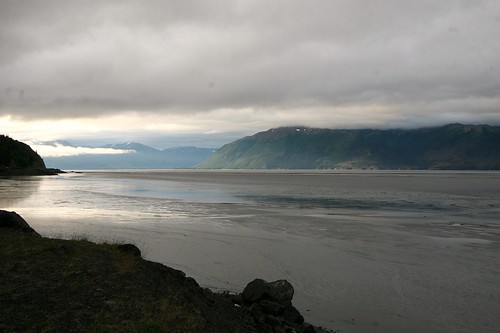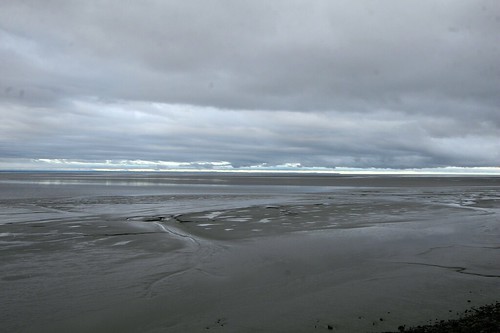Our trip to Alaska is over. We did relax. We did see some wildlife. I even got some life birds. And I took a ton of pictures. Too many pictures. Well...not "too many", but nearly that many. The constraints of time and Internet bandwidth have prolonged my upload of pictures until tonight...the last day's photos are uploading to Flickr as I type. Since I am shy (or picky...you decide) these piles of uploaded photos are all marked private until I get a chance to look them over, pick out my favorites, clean them up "just so" and mark them public. Some of these public photos will eventually end up in a future blog post. I already know there will be cute large-billed birds and large swimming mammals, but I am still in the thrall of discovery at the moment.
All I have for this post are a couple of mostly cloudy pictures of Turnagain Arm. Mostly cloudy was what we had every day, except for the last two, and maybe an hour or two here and there on the other days. No complaints here about the weather - you do not go to Alaska for warm, sunny, predictable weather - but it did pose some interesting photographic challenges.
Turnagain Arm is not an anatomical reference. It is a body of water. If you come up the south edge of the Alaska Peninsula, the Pacific Ocean transitions into the Gulf of Alaska which in turn transitions into Cook Inlet (with the Kenai Peninsula on your right and Anchorage to the north and east). When Cook Inlet gets to Anchorage, the waterway splits - Knik Arm continues to the north of Anchorage, while Turnagain Arm is to the south. According to Wikipedia, Turnagain Arm was named by none other than William Bligh (think Mutiny on the Bounty), who was working for Captain James Cook at the time, looking for the Northwest Passage. They did not find it up either "arm" of Cook Inlet. After exploring the second "arm" and reaching the end, they had to "turn again". And there you have it.
Your initial reaction when you see these two pictures might very well be "there is no water...only mud". And you would be mostly right. There was lots and lots of mud, and just a little bit of water. The tide was out when I took these photos. Turnagain Arm has the largest tidal range of any body of water in the United States. The difference between low tide and high tide water levels here is about 30 feet.
Enough of the trivia. Here are my two pictures of Turnagain Arm. Remember - mostly cloudy pictures of mostly mud. I am sure I will find something more interesting to share in the coming days :-)


1 comment:
Welcome home! Can't wait to see the large bills & swimming mammals!
Post a Comment